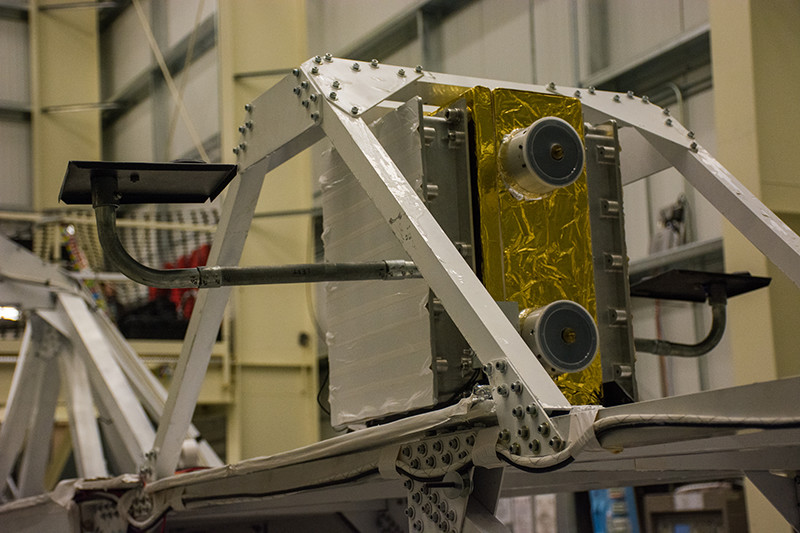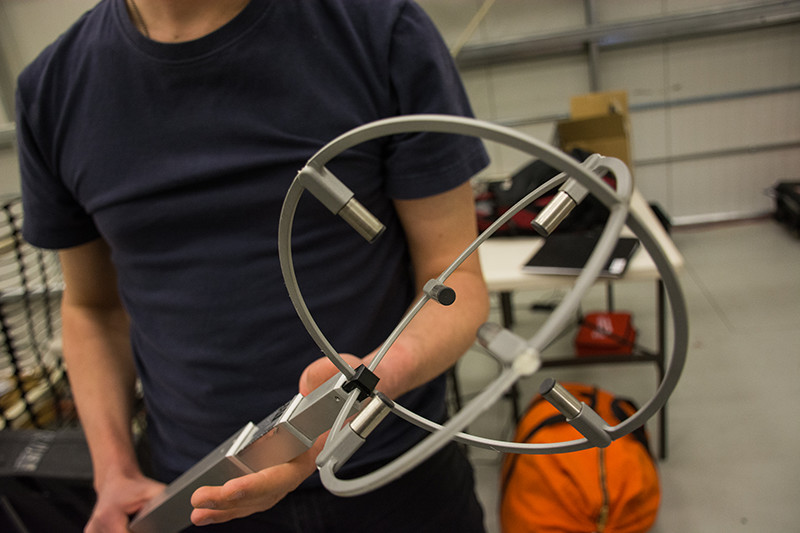
Photo Credit: Mike Lucibella
|
When GRIPS flew in January, it carried with it three piggyback experiments to test equipment in an outer space-like environment.
|
Sci in the Sky
The piggyback experiments that flew into the stratosphere with GRIPS.
By Michael Lucibella, Antarctic Sun Editor
Posted October 5, 2016
When the balloon-borne Gamma-Ray Imager/Polarimeter for Solar Flares (GRIPS) circled Antarctica, it wasn’t alone. The science payload carried with it three smaller experiments from researchers around the world. These experiments took advantage of extra space on GRIPS’ large chassis for projects that tested experimental detectors and techniques.
SMASH

Photo Credit: Mike Lucibella
Mounted on the side of GRIPS’ eight-meter-long boom, SMASH observed the x-rays of solar flares.
Positioned at the front of the boom was a small instrument that stared directly into the sun. It’s about the size of a loaf of bread, has two round X-ray detectors and a “fake moustache.” The Southwest Miniature Assembly for Solar Hard X-rays, or SMASH is, like GRIPS, looking for emissions from solar flares, but in the hard x-ray spectrum.
“SMASH uses two small, commercial hard X-ray detectors. They measure very similar things to what GRIPS is doing, but only a small piece of it. They’re much smaller, much cheaper detectors,” said Amir Caspi of the Southwest Research Institute in Boulder, Colorado and principal investigator of the experiment. “The GRIPS team was kind enough to give us a free ride on their balloon, letting us get access to near-space, which has a similar radiation environment as space.”
Even in the thin atmosphere 130,000 feet above the surface, only the highest energy X-rays can pierce through. On the balloon, the team hoped to detect X-rays as low as 20 kiloelectron volts, but in space it can detect signals from the sun as weak as 5 kiloelectron volts.
The flight was a test run for these detectors, which the researchers hope to fly on future space missions, including on miniature satellites called CubeSats.
“The intent of this balloon flight is basically to flight-qualify the detectors,” Caspi said. “We’ve already shown in the lab that these detectors work in the vacuum of space, and now we’re showing that they work in a near space environment.”
The two round detector baffles stick out from the front of the silver-colored case containing the experiment’s processors and data storage. Cheekily, the researchers affixed a small, fake mustache underneath the detectors so it resembles a face.
While there weren’t any major flares big enough for SMASH to definitively observe on the sun during the flight, the instrument worked as designed and collected data over the entire mission.
“Overall the flight for SMASH went great, everything functioned without any noted anomalies,” Caspi said. “The flight was successful, and the detectors are now considered ‘flight qualified.’”
SOLAR-T

Photo Credit: Mike Lucibella
Atop GRIPS’ boom, SOLAR-T observed the sun at the far end of the infrared spectrum.
Attached to the top of the boom is another instrument that took advantage of GRIPS’ ability to track the sun. SOLAR-T is helping scientists better understand the origin of solar flares.
“It’s looking at solar flares similar to GRIPS and SMASH, and it’s looking for small scale temperature fluctuations in the solar flares,” said Glenn Laurent of the Southwest Research Institute in Boulder, Colorado.
Unlike GRIPS and SMASH, which were looking for high-frequency emissions from the flares, SOLAR-T observed much longer wavelengths of light in a band largely unexplored by researchers.
The detectors were tuned to the terahertz frequencies of the electromagnetic spectrum; hence the “T” in SOLAR-T. They’re long wavelengths of light at the far end of the infrared spectrum, bordering on microwaves. These signals are emitted by the same accelerated particles that the GRIPS detectors are focused in on.
The water vapor in Earth’s atmosphere absorbs nearly all terahertz frequencies, making it almost completely opaque to any kind of usable signal. However the atmosphere 130,000 feet above the surface is so thin that the detectors can make out signals from the sun.
“Technical performance was fully accomplished,” said Pierre Kaufmann of the Universidade Presbiteriana Mackenzie in Brazil, the lead scientist on the project. “SOLAR-T was turned on in December 27, 2015, and remained functioning continuously for 37 days until GRIPS landed on January 30, 2016, without any failure.”
During that time it observed the first impulsive solar terahertz burst, allowing the team to determine the intensities of the flare’s emissions at the frequencies of 3 and 7 terahertz. The team is continuing their analysis on smaller flares they recorded.
TILDAE

Photo Credit: Mike Lucibella
Bennett Maruca holds up TILDAE, which uses sound waves to measure wind speed and atmospheric turbulence.
The third experiment getting a lift on GRIPS is the Turbulence and Intermittency Long-Duration Atmospheric Experiment, or TILDAE. It’s a sonic anemometer, a wind-speed detector that uses sound waves. Because the air is so thin at 130,000 feet, it might seem like an odd experiment to include on a balloon trying to fly above as much of the atmosphere as possible.
“It turns out there’s a lot of very good science that can be done,” said the co-principal investigator on the experiment, Bennett Maruca formerly at the University of California, Berkeley, now at the University of Delaware. “For one thing there just aren’t many good turbulence measurements up at that altitude.”
High in the stratosphere the air is generally much more stable than in the troposphere, near the surface. However there are still pockets of turbulence that are hard to study because of the difficulty getting instruments up to those high latitudes for long periods of time. The GRIPS flight afforded researchers the perfect opportunity to keep the anemometer in the skies for an extended stay.
The project’s co-principal investigator, Raffaele Marino, from the École Normale Supérieure de Lyon and the Università della Calabria, reached out to Applied Technologies of Longmont, Colorado, about sending the anemometer high into the stratosphere.
The small experiment sticking off of GRIPS’ chassis looks like an aluminum scepter, with two interlocked rings forming a small sphere at the end. Mounted on these rings are six transducers facing each other which act both as a microphone and a speaker.
“Between each pair it’s bouncing a sound signal back and forth and it measures the time,” Maruca said.
Moving air carries sound in the direction it’s blowing, changing its velocity. If there’s a strong gust of wind in a particular direction, one transducer will record the sound taking less time to reach it while its partner will record it taking longer. With this information, scientists can get a fix on the speed and direction of the wind currents the anemometer passes through. In addition to the wind, there are also other factors that affect the speed of sound in the atmosphere, which the device should also be able to detect.
“Another great thing about it, you’re directly measuring sound speed and by doing that we’re actually getting some very high temperature measurements,” Maruca said. “We’ll be able to connect turbulence with heating phenomena in the stratosphere.”
The device captured data during much of the balloon’s ascent, providing them insight into the behavior of an important region of the atmosphere.
“We're pleased with the outcome of the experiment,” Maruca said. “We successfully measured turbulence flow in the stratosphere. We're focusing our attentions on the data from the tropopause (the boundary between the troposphere and the stratosphere) and the lower stratosphere, as these regions play important roles in weather and aviation.”








